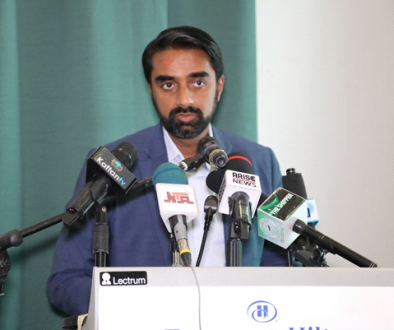Despite Knowing Its Roots, Why Does the Corruption ‘Beast’ Still Live Here?

You’ve heard the joke about the Chinese, Indian and Nigerian public officials. No? Well, they’d known each other for years but had only met at conferences. They decide to visit each other starting with the Chinese public officer. They fly to Beijing’s modern airport and on to a provincial city, then head down a pristine six-lane highway to a large suburban house. “This is a really nice house,” the Nigerian says. “How did you afford it on your salary?” “Well, you see that new highway we drove on? Should’ve been eight-lanes. I just took some money from the project and spent it on the house.” The other two nod, obviously impressed. Next, it was Delhi, then on to a little provincial town and a jolt down a potholed road until they get to the Indian’s large mansion. The Chinese officer asks how the Indian could afford it. “Well, that highway we drove on? I removed a bridge and some drainage from the project to pay for my house.” Finally, they headed to the Nigerian’s. Abuja airport is closed for runway refurbishment, so they fly to a smaller airport in the middle of nowhere, and board his helicopter, flying over slums to a palace surrounded by armed guards. There are slum dwellings as far as the eye can see. The Indian and Chinese politicians are amazed, and ask how he managed to afford such luxuries. “Well…”, he starts, “The main airport should have a second runway, and then a road through the slum to my village….”
This anecdote suggests that developing countries are purveyors of corrupt practices, perhaps in relation to their levels of (under)development, OR indeed that Nigerian politicians are greedier than their Chinese and Indian colleagues. But the former is debunked by a 2014 independent study commissioned by the EU Parliament that revealed budgetary corruption of approximately €1trillion euros; 14% of the entire EU GDP. We start therefore with the premise that corruption is universal, even if prevalence and impact is disproportionate. But what causes people or systems to facilitate or perpetuate corruption?
Transparency International (TI) publishes its annual Corruption Perception Rankings on a map, with the least corrupt nations coloured a mellow yellow and the most corrupt smeared in crimson which is often a point of commentary from news agencies such as Aljazeera. Unsurprisingly the ‘yellow’ areas are richer Western countries, whereas the ‘red’ areas mostly in the global South, with countries like Angola and Venezuela highlighted in deep crimson, lending credence to the conventional wisdom that corruption is a scourge of the developing world. The United Nations Convention against Corruption (UNCAC) goes further, asserting that “(corruption) is “most destructive” in the global South, … a major obstacle to poverty alleviation and development”. One would do well then, in establishing the causes of corruption, to examine those countries in which it appears most prevalent, and wrecks the most havoc.
As it turns out, I don’t have too far to go since I live in Nigeria (No. 136 on the 2016 TI Rankings), a place where (alleged) successive perpetrators of corruption appear to outdo each other, with no follow through to convictions. In 2015, NOIPolls published survey results revealing that Nigerians blame ‘weak public institutions’ (24%), ‘poverty’ (18%) and ‘resource scramble’ (11%) for the high prevalence of corruption in Nigeria amongst other factors. Even in the light of these justifications, my analytical background compels me to keep asking ‘WHY?’, after all in Botswana (aka No. 35), there are poor people too, same as Chile (24)!
Digging further down the causal chain, one starts to note specific factors, such as population size, government instability and natural resource wealth, which appear to be positively linked with the prevalence of corruption. Risks such as illness, accidents, and unemployment, are high in corruption-prone developing countries, and citizens lack risk-spreading mechanisms (including welfare, insurance and well-developed labour markets) available in wealthier countries according to the Anti-Corruption internet database, leading one to argue that the underlying reasons are NOT answered by the polled responses above; not without some prior catalysts that trigger the emergence of those secondary factors.
The causes of corruption at country level appear less specific and more contextual and environmental-rooted in traditions, political development and history. Corruption is widespread in developing countries, not because their citizens are different, but because prevailing conditions incentivise it. A defining characteristic of the environment in which corruption thrives is the divergence between formal and informal rules governing behaviour. Where corruption is systemic, the formal rules remain in place, but they are superseded by informal rules. Findings from a survey conducted by the CLEEN Foundation in collaboration with the McArthur Foundation in 2013 revealed that the foremost guardians of formal rules in Nigeria, the Nigeria Police Force, are perceived as the most corrupt government agency alongside the Economic Financial Crimes Commission (EFCC) and the Independent Corrupt Practices and Other Related Offences Commission (ICPC). Another school of thought from the World Bank holds that corruption tends to flourish when ethical values of a functional bureaucracy may have been eroded or never established.
‘Greed’ did not make it onto this top list of polled causes. Maybe it’s my irrational patriotism, but it would have hurt to suggest Nigerians are greedier than most. The ‘greed’ here is simply a rational wanting for more: more earned income…more improvements to one’s quality of life. More safety and protection for loved ones. That greed, if it can be so-called, is good and drives the Nigerian spirit of entrepreneurship, achievement and innovation to overcome poverty. These are the central planks of the Business Innovation Facility (BIF) programme, supported by DFID UK. BIF is geared towards working to improve the performance of markets that matter most to poor people; those that provide livelihoods and access to basic services. It seeks to understand how and why markets are failing to serve the poor. BIF effectively deploys market mechanisms to address the culture of corruption from the bottom up, by facilitating commercially sustainable innovations that have the potential to address the root causes that prevent market growth, many of which are tied to corruption, and limit the poor from economic participation as producers, consumers or employees.


